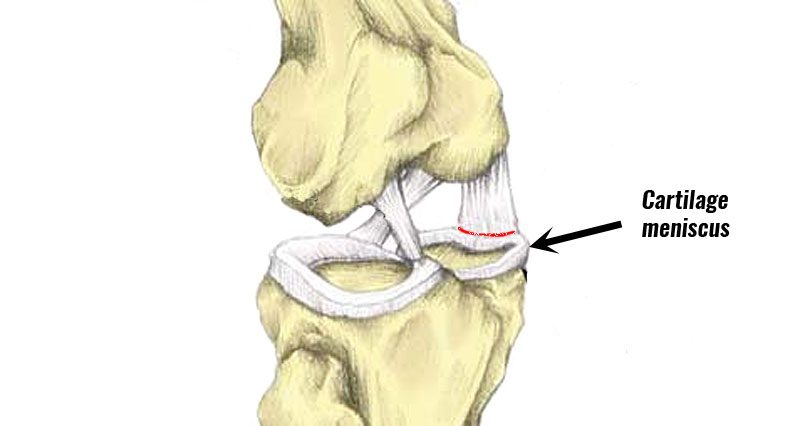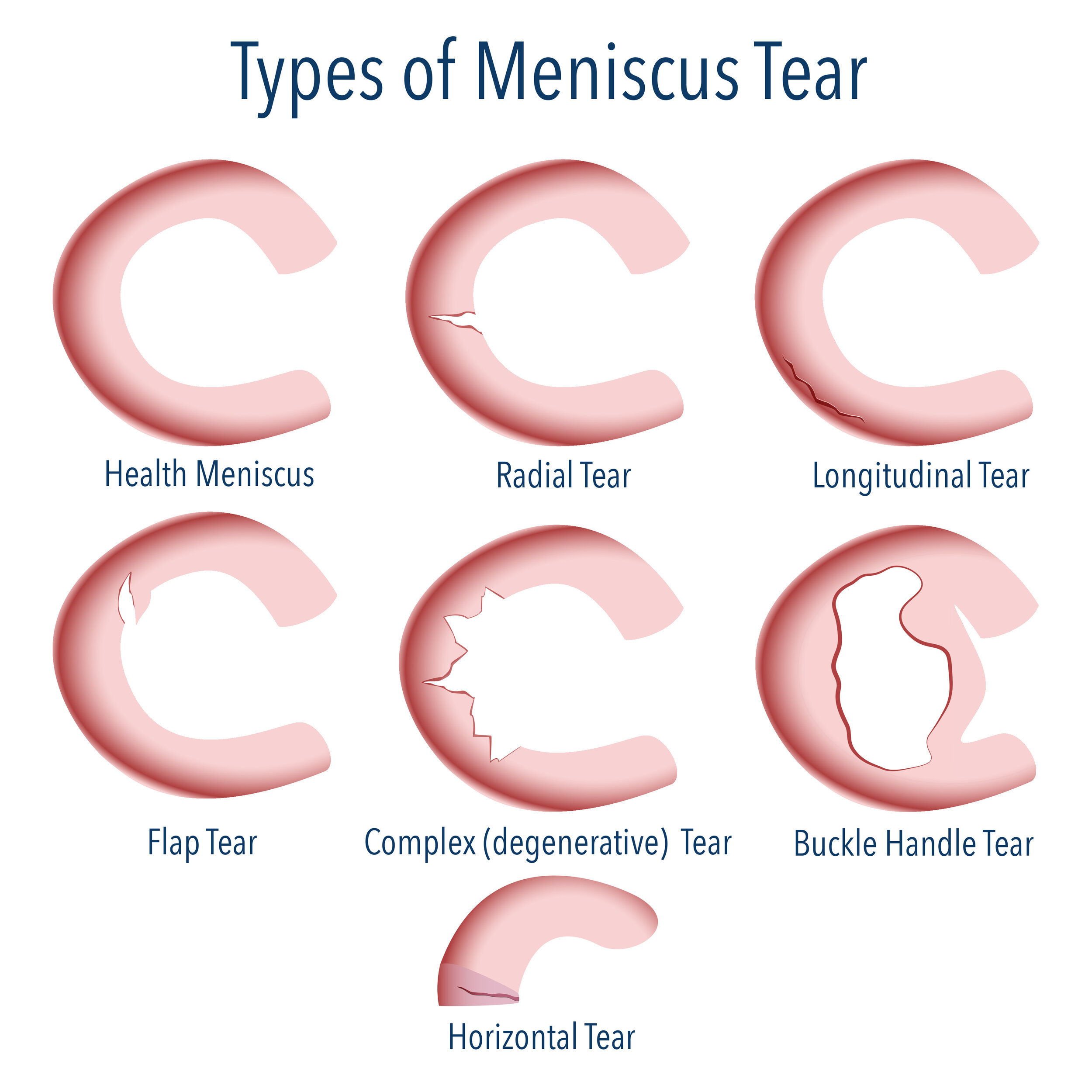Understanding Torn Meniscus

The meniscus is a C-shaped piece of cartilage that acts as a shock absorber between your thighbone (femur) and shinbone (tibia). It helps to distribute weight evenly across the knee joint, providing stability and cushioning.
Anatomy of the Meniscus and its Role in Knee Function, Torn meniscus
The meniscus is made up of two parts: the medial meniscus, located on the inner side of the knee, and the lateral meniscus, located on the outer side. Both menisci play a crucial role in maintaining the knee’s stability and smooth movement.
The meniscus acts as a shock absorber, distributing weight evenly across the knee joint and preventing excessive wear and tear on the cartilage.
Types of Meniscus Tears and their Causes
Meniscus tears can occur in various ways, leading to different types of tears.
Types of Meniscus Tears
- Horizontal tear: This type of tear runs across the width of the meniscus.
- Vertical tear: This tear runs along the length of the meniscus.
- Radial tear: This tear is a combination of a horizontal and vertical tear, resembling a radial pattern.
- Degenerative tear: This type of tear occurs due to wear and tear over time, often associated with aging.
Causes of Meniscus Tears
- Sudden twisting or pivoting motion: This is a common cause of meniscus tears, especially during sports activities like basketball, soccer, and skiing.
- Direct impact: A direct blow to the knee, such as a fall or a car accident, can also cause a meniscus tear.
- Degeneration: As we age, the meniscus can become thinner and weaker, making it more susceptible to tears.
Symptoms of a Torn Meniscus
The symptoms of a torn meniscus can vary depending on the severity of the tear.
Symptoms
- Pain: Pain is often the most common symptom, especially when twisting or bending the knee.
- Swelling: Swelling around the knee is another common symptom, which may develop gradually or suddenly.
- Stiffness: Difficulty bending or straightening the knee is a common sign of a torn meniscus.
- Clicking or popping sensation: Some people may experience a clicking or popping sound when they move their knee.
- Locking or catching: In some cases, the knee may lock or catch, making it difficult to move.
Risk Factors for Developing a Torn Meniscus
Certain factors can increase the risk of developing a torn meniscus.
Risk Factors
- Age: The risk of a torn meniscus increases with age, as the cartilage becomes thinner and weaker.
- Occupation: Jobs that involve repetitive kneeling, squatting, or twisting movements can increase the risk of a torn meniscus.
- Sports: Athletes who participate in high-impact sports, such as football, basketball, and skiing, are at higher risk of a torn meniscus.
- Obesity: Excess weight puts extra stress on the knee joint, increasing the risk of a torn meniscus.
Diagnosis and Treatment Options

Knowing you’ve got a torn meniscus can be a real bummer, but don’t worry, there are ways to figure it out and get you back on your feet. We’ll break down the process of diagnosing a torn meniscus and the different treatment options available, so you can understand what’s going on and make informed decisions about your recovery.
Diagnostic Methods
Diagnosing a torn meniscus usually involves a combination of methods, starting with a thorough physical examination. Your doctor will ask about your symptoms, how the injury happened, and examine your knee for tenderness, swelling, and range of motion. If your doctor suspects a torn meniscus, they’ll likely order imaging tests to confirm the diagnosis.
- Magnetic Resonance Imaging (MRI): This is the gold standard for diagnosing a torn meniscus. An MRI uses strong magnetic fields and radio waves to create detailed images of your knee joint, allowing your doctor to see the exact location and severity of the tear.
- Arthroscopy: This is a minimally invasive surgical procedure that allows your doctor to visualize the inside of your knee joint directly. A small camera and instruments are inserted through tiny incisions, allowing your doctor to see the torn meniscus and potentially repair it during the same procedure.
Conservative Treatment Options
If your torn meniscus isn’t causing significant pain or instability, your doctor may recommend conservative treatment options to manage your symptoms and allow your knee to heal naturally. These options include:
- RICE (Rest, Ice, Compression, Elevation): This is a common first-line treatment for many knee injuries, including torn menisci. Resting your knee, applying ice to reduce swelling, compressing the area with a bandage, and elevating your leg can help reduce pain and inflammation.
- Pain Medication: Over-the-counter pain relievers like ibuprofen or acetaminophen can help manage pain and inflammation. In some cases, your doctor may prescribe stronger pain medication if needed.
- Physical Therapy: A physical therapist can teach you exercises to strengthen your knee muscles, improve your range of motion, and help you regain your mobility. Physical therapy is crucial for restoring function and preventing further injury.
Surgical Treatment Options
If conservative treatment options don’t provide adequate pain relief or if your torn meniscus is causing significant instability, surgery may be recommended. There are two main surgical options for treating a torn meniscus:
- Meniscectomy: This procedure involves surgically removing the torn portion of the meniscus. It is often recommended for older individuals or when the torn portion of the meniscus is severely damaged and cannot be repaired.
- Meniscus Repair: This procedure involves stitching the torn portion of the meniscus back together. It is typically recommended for younger individuals with a less severe tear. Repairing the meniscus can help preserve its function and reduce the risk of long-term knee problems.
Comparing Conservative and Surgical Treatment Options
The best treatment option for a torn meniscus depends on factors like your age, activity level, the severity of the tear, and your overall health.
- Conservative treatment is often the first-line approach, especially for less severe tears. It’s generally less invasive and carries a lower risk of complications compared to surgery. However, it may not be effective for all individuals, and it may take longer to recover fully.
- Surgical treatment is typically reserved for more severe tears or when conservative treatment fails. It can provide faster pain relief and restore function, but it comes with the risks associated with any surgical procedure, including infection, bleeding, and potential complications.
Rehabilitation and Recovery: Torn Meniscus

Recovering from a torn meniscus requires a dedicated rehabilitation program to regain strength, flexibility, and mobility. This process involves a combination of exercises, physical therapy, and careful adherence to your doctor’s instructions.
Rehabilitation Program
A comprehensive rehabilitation program for a torn meniscus typically involves three phases:
* Phase 1: Initial Recovery (Weeks 1-4)
* Focus: Reducing pain and inflammation.
* Exercises: Rest, ice, compression, and elevation (RICE), gentle range-of-motion exercises, and isometric exercises (muscle contractions without movement).
* Phase 2: Strengthening and Flexibility (Weeks 4-8)
* Focus: Increasing strength, flexibility, and range of motion.
* Exercises: Progressing to more challenging exercises like squats, lunges, hamstring curls, and calf raises.
* Phase 3: Return to Activity (Weeks 8-12 and beyond)
* Focus: Gradual return to sports and activities.
* Exercises: Focus on functional exercises that mimic the movements involved in your chosen activities. This may include plyometrics (jumping exercises), agility drills, and sport-specific training.
Expected Recovery Timeline
The recovery timeline for a torn meniscus can vary depending on the severity of the tear, the type of surgery performed, and individual factors.
* Non-surgical treatment: Recovery may take several weeks to months.
* Surgical treatment: Recovery can take several months, and it may be longer for more complex procedures.
Potential Complications
While most people recover well from a torn meniscus, potential complications can occur, including:
* Infection: This is a rare complication but can be serious.
* Stiffness: Limited range of motion can occur if the joint is not properly mobilized.
* Delayed healing: This can happen if the wound does not heal properly.
* Re-tear: The meniscus can tear again, especially if you return to activity too soon or engage in high-impact activities.
Post-Operative Care Plan
Following a post-operative care plan is crucial for successful recovery. This plan may include:
* Medication: Pain relievers and anti-inflammatory medications may be prescribed.
* Physical therapy: Regular physical therapy sessions are essential for regaining strength, flexibility, and range of motion.
* Weight-bearing restrictions: You may be advised to limit weight-bearing on the affected leg.
* Follow-up appointments: Regular follow-up appointments with your doctor are necessary to monitor your progress and ensure proper healing.
Preventing Future Meniscus Injuries
While some meniscus tears are unavoidable, you can take steps to reduce your risk of future injuries:
* Warm up properly: Before any activity, warm up your muscles with dynamic stretching.
* Use proper technique: Use proper form when lifting weights, running, and participating in sports.
* Wear supportive footwear: Choose shoes that provide good support and cushioning.
* Maintain a healthy weight: Excess weight can put extra stress on your joints.
* Strengthen your muscles: Strong muscles help to stabilize your joints and reduce the risk of injury.
